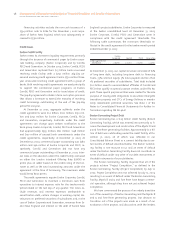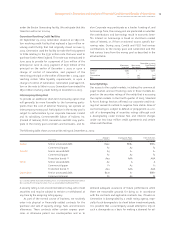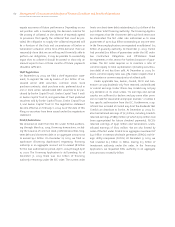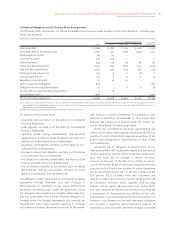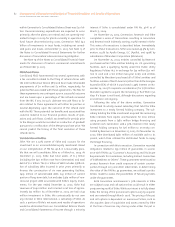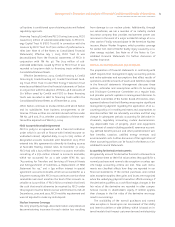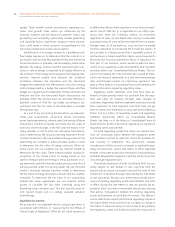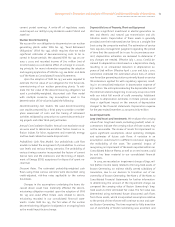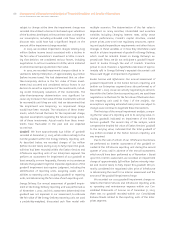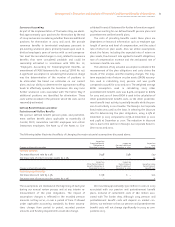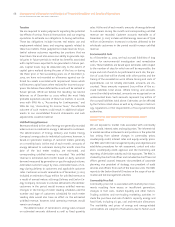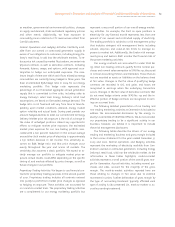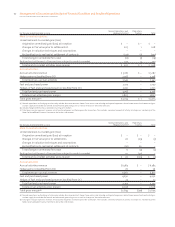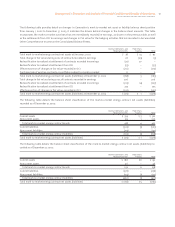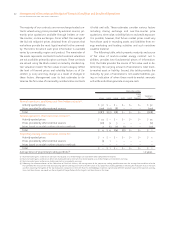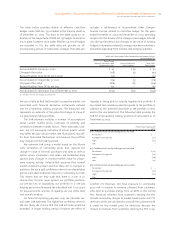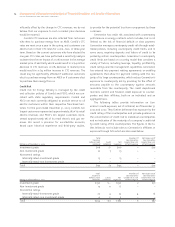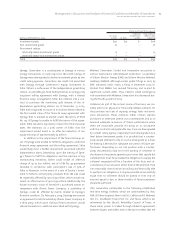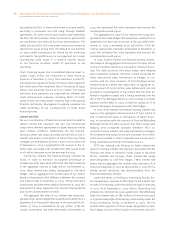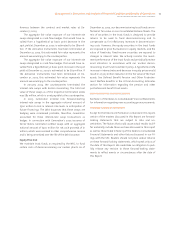ComEd 2003 Annual Report Download - page 70
Download and view the complete annual report
Please find page 70 of the 2003 ComEd annual report below. You can navigate through the pages in the report by either clicking on the pages listed below, or by using the keyword search tool below to find specific information within the annual report.68 Management’s Discussion and Analysis of Financial Condition and Results of Operations
EXELON CORPORATION AND SUBSIDIARY COMPANIES
Taxation
We are required to make judgments regarding the potential
tax effects of various financial transactions and our ongoing
operations to estimate our obligations to taxing authorities.
These tax obligations include income, real estate, use and
employment-related taxes and ongoing appeals related to
these tax matters. These judgments include reserves for po-
tential adverse outcomes regarding tax positions that we
have taken. We must also assess our ability to generate capi-
tal gains in future periods to realize tax benefits associated
with capital losses expected to be generated in future peri-
ods. Capital losses may be deducted only to the extent of
capital gains realized during the year of the loss or during
the three prior or five succeeding years. As of December 31,
2003, we have not recorded an allowance against our de-
ferred tax assets associated with impairment losses which
will become capital losses when realized for income tax pur-
poses. We believe these deferred tax assets will be realized in
future periods. While we believe the resulting tax reserve
balances as of December 31, 2003 reflect the most likely
probable expected outcome of these tax matters in accord-
ance with SFAS No. 5, “Accounting for Contingencies,” and
SFAS No. 109, “Accounting for Income Taxes,” the ultimate
outcome of such matters could result in additional adjust-
ments to our consolidated financial statements and such
adjustments could be material.
Unbilled Energy Revenues
Revenues related to the sale of energy are generally recorded
when service is rendered or energy is delivered to customers.
The determination of Energy Delivery and Exelon Energy
Company’s energy sales to individual customers, however, is
based on systematic readings of customer meters generally
on a monthly basis. At the end of each month, amounts of
energy delivered to customers during the month since the
date of the last meter reading are estimated, and
corresponding unbilled revenue is recorded. This unbilled
revenue is estimated each month based on daily customer
demand measured by generation or gas throughput volume,
estimated customer usage by class, estimated losses of en-
ergy during delivery to customers and applicable customer
rates. Customer accounts receivable as of December 31, 2003
included an estimate of $452 million for unbilled revenue as
a result of unread meters at Energy Delivery and Exelon En-
ergy Company. Increases in volumes delivered to the utilities’
customers in the period would increase unbilled revenue.
Changes in the timing of meter reading schedules and the
number and type of customers scheduled for each meter
reading date would also have an effect on the estimated
unbilled revenue; however, total operating revenues would
remain unchanged.
The determination of Generation’s energy sales is based
on estimated amounts delivered as well as fixed quantity
sales. At the end of each month, amounts of energy delivered
to customers during the month and corresponding unbilled
revenue are recorded.
Customer accounts receivable as of
December 31, 2003 include unbilled energy revenues of $366
million at Generation. Increases in volumes delivered to the
wholesale customers in the period would increase unbilled
revenue.
Environmental Costs
As of December 31, 2003, we had accrued liabilities of $129
million for environmental investigation and remediation
costs. These liabilities are based upon estimates with respect
to the number of sites for which we will be responsible, the
scope and cost of work to be performed at each site, the por-
tion of costs that will be shared with other parties and the
timing of the remediation work. Where timing and costs of
expenditures can be reliably estimated, amounts are dis-
counted. These amounts represent $105 million of the ac-
crued liabilities total above. Where timing and amounts
cannot be reliably estimated, amounts are recognized on an
undiscounted basis. Such amounts represent $24 million of
the accrued liabilities total above. Estimates can be affected
by the factors noted above as well as by changes in technol-
ogy, regulations or the requirements of local governmental
authorities.
QUANTITATIVE AND QUALITATIVE DISCLOSURES ABOUT
MARKET RISK
We are exposed to market risks associated with commodity
prices, credit, interest rates and equity prices. The inherent risk
in market-sensitive instruments and positions is the potential
loss arising from adverse changes in commodity prices,
counterparty credit, interest rates and equity security prices.
Our RMC sets forth risk management policy and objectives and
establishes procedures for risk assessment, control and valu-
ation, counterparty credit approval, and the monitoring and
reporting of derivative activity and risk exposures. The RMC is
chaired by the chief risk officer and includes the chief financial
officer, general counsel, treasurer, vice president of corporate
planning, vice president of strategy, vice president of audit
services and officers from each of the business units. The RMC
reports to the Exelon Board of Directors on the scope of our de-
rivative and risk management activities.
Commodity Price Risk
Commodity price risk is associated with market price move-
ments resulting from excess or insufficient generation,
changes in fuel costs, market liquidity and other factors.
Trading activities and non-trading marketing activities in-
clude the purchase and sale of electric capacity, energy and
fossil fuels, including oil, gas, coal and emission allowances.
The availability and prices of energy and energy-related
commodities are subject to fluctuations due to factors such


